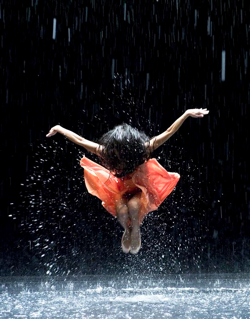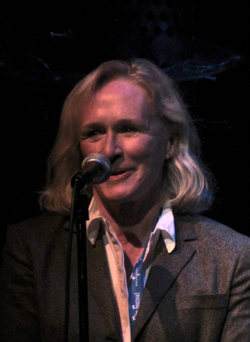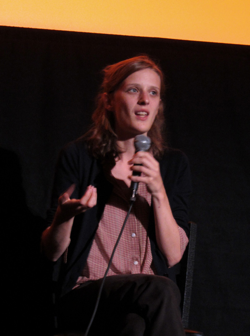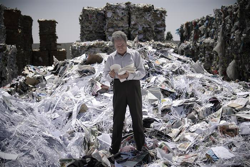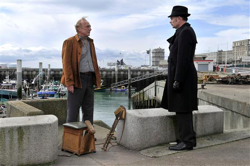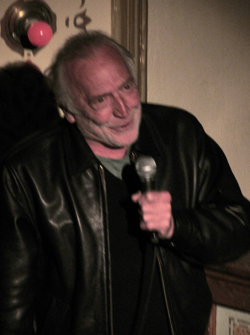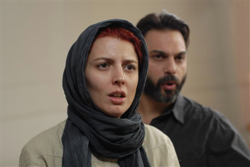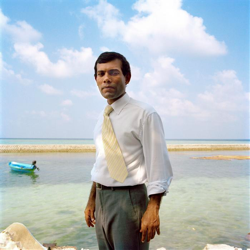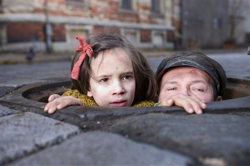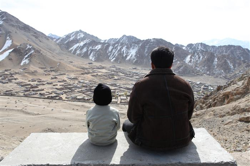There was a minor email kerfuffle amongst the press corps just prior to this year’s Telluride Film Festival. We received an announcement that there would be no photography at the George Clooney tributes. I immediately announced back that Mr. Clooney couldn’t take my picture either. Turns out it was a miscommunication, the proper message was ‘no flash photography’ and it wasn’t specific to George Clooney events. No flash photography is the normal policy anyway so this was a no-news announcement. The fact George Clooney would be there, as the subject of one of the tributes, that was news. The other tributes were to Tilda Swinton and Pierre Etaix. As is usually the case with tributes the subject has a new movie to show. In this case Mr. Clooney’s new film was The Descendants (review below) while Ms. Swinton’s new film was We Need to Talk About Kevin. We didn’t get a chance to see the latter film but the comments from fellow festivers were positive about the film but with warnings that it was very hard to watch. Indeed this was one of the darker festivals in years with many films dealing with tough subjects.
Attendance was as it’s been in previous years, very nearly sold out of the main festival passes about a week before the festival. Some people were shut out of certain movies. Invariably this happens with movies the festival shows as ‘sneak previews’. These are movies that already have distribution and are expected in theaters soon. In this case the movie was Butter starring Jennifer Garner and Hugh Jackman. Ms. Garner was in attendance, amplifying the overcrowding. We didn’t get to see Butter but reports were quite positive. Something like a butter carving contest as a metaphor for the current political situation in the US with characters in the movie perhaps having obvious analogs in today’s headlines.
Last year I wrote an extensive section on 3D at Telluride. This year there was only one 3D presentation, the movie Pina by Wim Wenders (Buena Vista Social Club). See the full review below. There were other technical overhauls this year though with many theaters getting a sound upgrade courtesy of Meyer Sound. The sound was really good, not sure I can say it was better than in previous years, my aural memory isn’t quite that good. The ratio of digitally projected films to conventional 35mm prints seems to still be on the rise with some directors specifically asking for digital and even exotic projection rates such as 25 fps. Telluride is also showing more documentaries each year it seems, nowhere near the number that Sundance shows however but Sundance is a much larger and longer festival. This year every feature was preceded by a short film, almost all of them excellent.
Even though we were able to get to 18 screenings (three of them being shorts programs) there were as always, films we would have liked to have seen but couldn’t get to. Besides Butter and We Need to Talk About Kevin there was Living in the Material World a four hour documentary on the life of George Harrison by none other than Martin Scorsese. Widely praised by all who saw it, it is slated to be on HBO in mid October.
Notables at the festival: George Clooney, Tilda Swinton, Glenn Close, Jennifer Garner, Shailene Woodley and directors Wim Wenders, Alexander Payne, Warner Herzog.
The Decendents
The latest film from director Alexander Payne (Sideways), this one based on the novel by Kaui Hart Hemmings has George Clooney playing a father, becoming a widower, while simultaneously presiding over a cadre of his wealthy cousins that must agree on what to do with a parcel of pristine Hawaii that has been passed down to them. That all sounds a bit contrived I suppose but the premise gives ample room for commentary and interpretation about the environment, land rights and wealth as well as family of course. Thankfully the movie makes these statements subtly, as part of the story. The pleasure in this movie is seeing Mr. Clooney in one of his purely dramatic roles. He clearly deserves the tribute paid to him at this year’s Telluride. Shailene Woodley (tv: The Secret Life of an American Teenager) plays the daughter and anchors the many fine performances at the heart of the movie. There are many, many characters in the film which was of course shot on location so some of the performances on the periphery a little rough but that is not uncharacteristic for this director. The music is 100% Hawaiian, much of it by famed slack-key guitarist Gabby Pahinui and this alone is worth the price of admission. The film is well worth seeing.
At the Q&A George Clooney joked that he was able to summon the tears needed for one scene by remembering that Director Alexander Payne refused to cast him in Sideways. I wish we could see some of these movies made with the alternate casting, or maybe just a short with some of the key scenes. It would be like when a band does a cover song. Both tribute and re-interpretation that add to the original. Clooney sat in the audience for the screening I attended and I was able to meet him at a party for the press during the festival. If you were wondering if he’s really like he seems, he is.
Pina
Director Wim Wenders (Buena Vista Social Club, Wings of Desire) had met dancer Pina Bausch twenty years before making this movie and for twenty years he had been telling her that he would make a movie about her. He just had to figure out how to adequately capture dance on film. The answer finally came when he saw U2 3D. Yep.
The filming for Pina commenced just as Ms. Bausch was diagnosed with a cancer that would claim her life before she could see the film. This of course makes the film that much more of a tribute to the career of this important choreographer. In the Q&A after the showing Mr. Wenders said that this was the first 3D film shot in real locations. I don’t know if that’s entirely true – I think some of the Harry Potter films used some outdoor locations but I get his point. However, to me these locations showed the continued limits of 3D. The backgrounds, even though they were actual planet Earth locations, often looked fake. The 3D technology is still not convincing enough to make something look real. Still, for these purposes (trying to capture and portray dance performance), it works famously. The Telluride audience was thrilled. I’d like to see a 2D version before I say that the film absolutely would not work in 2D but I’m leaning that way. If your wife is a fan of dance but is not sure about your expensive 3D-capable home theater, buy this movie.
Albert Nobbs
This is Glenn Close’s baby. Based on a novel by Gordon Steel, Close first helped to write, produce and then starred in the play. It took her 18 years to finally get enough backing for the movie (what is up with that Hollywood? Honestly). For the film she again has writer and producer credits as well the starring role and she helped to write the song played over the closing credits (sung by Sinead O’Connor). Ms. Close plays Albert Nobbs, a woman posing as a man in order to get work in 19th century Ireland. The film is as much about class differences as it is about sex discrimination. The costumes and sets are flawless and the acting is great throughout the cast. Mia Wasikowska plays a younger maid in the hotel with a strong Irish accent of course and I absolutely did not recognize her, she played Joni in The Kids Are Alright, one of my favorite films from last year.
Ms. Close sat in the audience for the screening on opening night of the festival and stayed and talked with audience members in the aisle well past the closing credits. Look for Glenn Close to get a best actress nomination for this one. Mia Wasikowska should get best supporting.
The Forgiveness of Blood
Director Joshua Martin Marston must have a travelling gene. His first feature, Maria Full of Grace was about a woman working as drug mule, travelling from Columbia to New York. For this film Marston went to Albania for the duration. Intrigued by news reports of blood feuds where eye for an eye justice is carried out family to family as it has been for centuries, he wondered how this works and what it looks like in the age of the internet and cell phones. Using a 100% local Albanian cast and crew this film is another example of the amazing acting talent that is available to directors working outside of the Hollywood system. Not that it was particularly easy, the director spent 6 months finding and training the actors he wanted. Then, in a supreme display of irony, the production was almost shut down on two occasions when fights, which then became blood feuds themselves, broke out amongst the crew. The driving force that seems to perpetuate these feuds is machismo. Women have some sway in these situations and in Albanian society in general but only behind the scenes. They can increase their status by renouncing their woman hood – becoming a ‘sworn virgin’. Like Maria Full of Grace, this film doesn’t attempt to comment on or solve these factors, it simply wants to show what it’s like for people. As such it doesn’t follow any of the accepted Hollywood precepts for action or script timing but if you give it a chance it will take you there.
Telluride showed this director’s first short (Box of Queens) in 1998, Maria Full of Grace in 2004. Joshua Marston has returned to Telluride on his own, purchasing a festival pass, each of the other years.
Goodbye First Love
This film was selected for Telluride only weeks before the festival, knocking something else from the program. A French film through and though, it seeks to find the motivations of its characters. A young girl and a young man are deeply in love. He has a penchant for travelling however while she seems to seek out stability. While she is still in high school, he is taking off to spend a year in central America. We stay with the girl and watch as the tides of the relationship change. The film does a great job of establishing the motivations for some dark behaviors but the director didn’t agree. She said that her goal was to explain how one person could have extremes of light and darkness but that she didn’t quite succeed. No arguments though that the film has a poetic quality and soars on many other counts, for a while I was considering it my favorite at this year’s festival.
In the Q&A the director Mia Hansen-Love said that she considered this film a completion of a trilogy with her first two films: Father of My Children and Tout est Pardonne
Bitter Seeds
We’ve all heard about Indian farmers committing suicide in part due to financial ruin brought on by the questionable business practices of Monsanto which is forcing the use of their non-reusable, genetically modified seeds. Now you can see it. Filmed entirely in rural India, we follow one farmer in particular and see the workings of Monsanto on the entire village. For thousands of years these farmers grew cotton from natural seeds, fertilizing them with cow dung. The natural seeds were available from their own plants if they harvested for that or from their neighbors in the next village. With heavy handed marketing and questionable claims Monsanto gets everyone to switch to their expensive, non re-usable seeds in the same year. The justification for the higher cost is higher yields which invariably don’t pan out. The genetically modified plants are designed to have immunity to one bug or another but are highly susceptible to fungi (for instance). But, since everyone in the area has switched, there are no natural seeds available. These farmers are not rich and so have to take loans to try with the same questionable seeds the next year. The movie doesn’t say what the end game might be but it seems as though having this multitude of small farmers take themselves out of the game might open up a land buying opportunity for big agribusiness. The movie is well made and should be seen by all.
“Competition in academia is so vicious because the stakes are so small” Henry Kissinger. This Israeli movie was born when director Joseph Cedar got a phone call that he thought must have been meant for his father. The call was from the Italian embassy in Israel. They were wanting to celebrate the 60 year anniversary of the founding of Israel. While Cedar is a well known director in Israel he thought they must have meant his father who as a bio-chemist won the prestigious Israel Prize. The person making the call said, “Oh… ummm.. let me check”. Nope, they had the right man. The premise got him to thinking about father-son dynamics and got him started writing a script after a long drought. Study of the Talmud, the central text of Judaism, is a huge and well-followed field in Israel, seemingly populated by Asperger Syndrome candidates who meticulously analyze numerous examples of hand copied versions of the book, scouring them for minute differences. This is the ingenious setting for a riveting father-son drama. It’s hard to describe how a movie can take such a seemingly unfilmable premise and draw you in so deeply. My one quibble with the movie is the music though you might view it as a strength. There is a rather overbearing soundtrack of classical-inspired music. The director had the problem that he wanted the overall tone to be light but the emotions are intense, he installed the music like another character to lighten things up. It works, but I found it rather heavy handed, it reminded me of Bugs Bunny or Road Runner cartoons. (I’m not a classical music fan so that might color my opinion).
La Havre
If you’ve seen any of the previous films by Finnish director Aki Kaurismäki (The Man Without a Past) you don’t need me to tell you to go see this one. For everyone else, I’m telling you, see this movie. The movie is set in modern day France in a small town called La Havre but it looks like it was filmed in the 1960’s or earlier. The only clues that the times are modern are the cell phones and the opening scene where a single boy escapes from a police raid on a cargo container full of people attempting to smuggle themselves into England. Two distinctly modern problems. The film goes on to play out a beautiful and heartening picture of a community with few resources coming together to help out one of their own. There are numerous sight gags and situations that make the movie hilarious as well. It will stick with you long after you see it. Well worth owning.
The director wasn’t available at the screening I attended but the star of the film, French actor André Wilms, after complaining about having to be there for a 9 am screening, demonstrated how the director overcame their language barrier by whistling and pointing where he wanted the actor to go.
The Kid With a Bike
The Dardenne brothers (Jean-Pierre and Luc) are Telluride favorites. Their previous film l’enfant (also titled ‘The Child‘) played at the festival in 2005 and like The Kid with a Bike, won the Palme d’Or at the Cannes film festival. L’enfant mopped the floor with audiences at Telluride in 2005 with its intense emotional journey as an irresponsible young father decides to sell his infant son into the black (adoption) market. While not explicitly stated this film seems to be the continuation of that story as the actor who played that father is now the father of an 11 year old boy. Again he abandons the boy, leaving him in an adoption agency and refusing contact. The boy is as full of life as his young father was and is not easily left behind. I’d love to go on about what happens next but you should see this film (and its predecessor). While both l’enfant and The Kid With a Bike are ripe with emotion both are ultimately very positive about humanity and human nature. The ride is so intense you don’t always get that until you reflect on what you’ve seen. The kid playing the kid, first time actor Thomas Donet is so good, he could have carried the film all on his own if needed. What is it with kids these days?
See more reviews including my favorite film from Telluride 2011 in part two…

Annette Insdorf leads a panel discussion at the Labor Day picnic 
A Separation
This is my favorite film from Telluride this year. It’s an Iranian film but it is not allegorical or even suitable for children like many Iranian films are forced to be. It begins with a couple pleading their respective cases before a judge. She is asking for a divorce because they have been granted exit visas, a chance to take their young daughter to the west. The visas expire in a few months but the father doesn’t want to leave as his own father has succumbed to Alzheimer’s disease and needs constant care. The divorce isn’t granted but the wife moves out. Since she was the one providing care for the Alzheimer’s stricken father there is a problem to solve. People do their best to solve the problem within the extreme pressures applied by the repressive society. The result will be for the legal system to decide. This view into the Iranian legal system is an unexpected treat from this film. The key difference in their system is that there are no lawyers. Plaintiffs and defendants argue their cases passionately in front of the judge. The acting is flawless throughout and your heart will go with each of characters in this film. This movie won awards for acting and best film at the Berlin Film Festival.
There is only one scene in the film that I would think of as politically sensitive in Iran. It goes by very quickly but in the opening scene when the couple is pleading their case for divorce the wife makes the point that she wants to take advantage of the exit visas so that their daughter doesn’t have to grow up ‘under these conditions’. The judge asks her ‘What conditions?’, she looks away.
The Island President
In 2008 Mohamed Nasheed became the first democratically elected president of the Island nation of the Maldives. There is more to the story. The force of this man as a politician and the fact that he granted full access to the documentary crew with no say over the edits or final product would be enough to make this documentary worth watching. The story makes it a must see.
The previous president of Maldives, Maumoon Abdul Gayoom who had held power for 30 years, reportedly instituted a program of terror, torture and detention to control his political enemies almost from day one of his presidency. Among those detained, Mohamed Nasheed. The international community was able to force Gayoom to hold a free and open election as a condition of receiving aid after a Tsunami severely damaged the island community. When Nasheed became president, he reached international prominence trying to protect his island nation from a slower but longer lasting wave, the expected rise of the oceans due to global warming. “It won’t do any good to have a democracy if we don’t have a country”.
Nasheed is widely credited with salvaging the Copenhagen Climate Change Conference in 2009 and the movie does a great job of showing this. We also see a brief glimpse of a beaming Hillary Clinton after she and Barack O’bama successfully intervened in what was to be a private meeting of the developing countries of Brazil, Russia, India and China, a group that was responsible for blocking progress at the summit. According to the German citizen sitting next to me during the screening this intervention by the US was unprecedented and pivotal and underreported in the US. At the time of the summit, the fact that an agreement was reached at all was considered a huge step forward. The agreement had no enforcement mechanism however and recent news has shown that countries have not slowed their CO2 contributions.
Still, the reason to see this movie is to be reminded what an honest, forceful politician looks like. The first ever footage shot from a helicopter (as opposed to an unsteady small airplane) of these beautiful islands is also reason enough to see this film.
During the Q&A director Jon Shenk told about some of the footage that had to be left on the cutting room floor. After travelling to the Copenhagen Climate Summit President Nasheed realized that he had forgotten to pack his tuxedo, needed for a formal party he was slated to attend. The documentary crew followed him as he called finance ministers (or somebody) to get authorization for the purchase of a new one, found a shop that could tailor a tux that same day, journey back to the hotel room and then on the phone discovers that the party was not formal. Let’s hear it for DVD extras.
Shame
British conceptual artist and filmmaker Steve McQueen was at the 2008 Telluride festival with his first film Hunger starring Michael Fassbender as IRA hunger striker Bobby Sands. During the Q&A he shared the audience’s amazement at the depth and dedication of the performance but he also remarked that in real life his young star was more interested in parties and young ladies than spiritual matters as might have been indicated by the performance. He had a sly smile though when he said something like ‘we’re trying to him bring him around though’. I have no idea if that was the inspiration for this latest collaboration between the two. It sort of seems like it though. In this film Fassbender plays a sex addict coming to terms with his addiction. There’s not much more to say about the story. The film is similar to Hunger in that the artistic sensibilities of Steve McQueen drive every shot. Each one is like a long, composed photograph. Michael Mann (Miami Vice, Collateral, Heat) is a similar US director but there is slightly less polish, more grittiness in the McQueen films so far. If released in the US this film would certainly receive an NC-17 rating.
Carey Mulligan once again delivers an amazing performance, so much so that I didn’t recognize her even though I was reminding myself that she was in the film as it started.
In Darkness
This is another amazing story of Jews escaping Nazi persecution. This time by hiding in the sewers of the Polish city of Lvov. They receive vital help from a con-man/scavenger living above ground. The film shows how antisemitism was rampant though of course it was the Germans who really ran with it. This movie has such high production value and such a compelling story it is easy to recommend. I wonder how far it will go however. The Counterfeiters and even the The Lives of Others have not gotten the audience they deserve.
It amazes me how these incredible films seem to come out of nowhere. The acting, direction, photography and editing are all so tight in this film, Hollywood could take a lesson. The film guide for this year’s festival credits ‘Master Director’ Agnieszka Holland. Her most recent experience is a TV director for Treme. Previously she had also directed episodes of The Wire and in the 1990’s she collaborated with Krzysztof Kieslowski on the writing of his famous Three Colors trilogy. Ok, maybe that explains it.
Since you are reading this review on hometheaterhifi.com I can also recommend In Darkness as an excellent test of your system’s black levels when it comes out on disk.
The Way Home
This was the only film I saw at this year’s festival that I can’t recommend. The festival directors touted it as a rare example of independent (non-Bollywood) Indian cinema. It may be but if so, it shows that there’s a reason for said rarity. The production values on this film are below any modern student film. Acting is stiff and unbelievable which is a good match for the story I suppose. The premise is that a dying Indian woman (she seems to be dying from two small cuts on her face) has a 5 yr old child that she is entrusting to the doctor attending her. The child was conceived during a single encounter with a famous Pakistani terrorist leader. The doctor decides that he must return the child to this man to give them both the best chance at a good life. The filmmakers are obviously trying to make some sort of statement about how India and Pakistan should attempt to get along. This just seems to give them an excuse for unrealistic dialogue. The one redeeming thing I can think of – the film is a travelogue of the Himalayan mountains.
The Artist
This film was the favorite of many attending the festival this year. As is usual at Telluride most of the movies have a dark theme (but usually an uplifting twist on the story if you’re paying attention). This one is just pure (eye and brain) candy. Filmed in black and white and 99% silent (ie, music but no dialogue) The Artist shows us the transition from silent to talking films from the point of view of (fictional) silent film star George Valentin who finds himself left behind by the Hollywood system that just the day before couldn’t live without him. John Goodman is the most recognizable star in this and he is the perfect cigar-chomping movie mogul.
I found the movie dragging on a bit at times but perhaps they were being true to the silent films which inspired this film. In any case, it didn’t seem to be a factor for anyone else so I still heartily recommend this movie for when you’re ready for something lighter.







